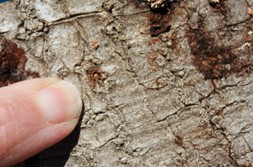No Turning Back for Diseased Oak Trees

By Christina Phillis
Just as easily as you can catch a cold, plants can catch and pass on diseases to each other. One such disease, known as “sudden oak death,” is killing oak trees across Northern California.
The plant pathogen causing the devastation is called Phytophthora ramorum. It is a water mold that penetrates trees through their bark, killing them within one to five years. It annihilates the vascular system of trees by attacking its cambium, the layer between the wood and bark. Because many species of trees can carry the mold without showing any symptoms, it’s very easy for the disease to spread and not be caught or contained.
The first signs of the disease occurred in 1995. P. ramorum is believed to have entered the United States with imported ornamental plants. A new study, published by researchers at the University of California-Davis, estimates that the last chance to stop it was in 2002. The team used a disease model that is similar to those used to track human pathogens. Even if a full-scale effort was employed today, the model predicts that forests along the west coast would be consumed and billions of trees would be put at risk.
Stopping the Spread
The best method to try to beat the disease would involve cutting down oak trees and other carriers that border the infected areas in an effort to prevent it from progressing any farther. Wildlife officials in Oregon saw some success with similar methods, but the disease ended up spreading anyway because their efforts came too late.
The greatest obstacle to containing this disease is a lack of funds. If the California Department of Forestry and Fire Protection were to spend its full 2015-16 budget of $90 million, about 9,000 square miles of oak forest would still be lost. Using the same amount of resources 10 years ago would have resulted in a loss of about 5,000 square miles.
Dealing with the Aftermath
California’s oak trees serve as “keystone species,” meaning they support ecological communities of other plants and animals. There are 300 different species in California that live in habitats made up mostly of oak trees. The effects of this disease will substantially alter the state’s biological diversity.
At this point, the state of California must focus on living with and managing the disease. Moving forward, this will involve restoring affected areas, removing infected trees and deploying beneficial wildfires.
CLASSROOM DISCUSSION
- Describe the potential effects of “sudden oak death” on surrounding plants and animals.
- Besides widespread pathogens, what other large-scale events have the potential to alter ecosystems?
VOCABULARY
- Pathogen
- Species
- Ecological